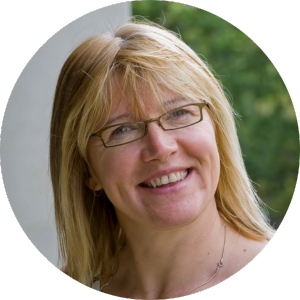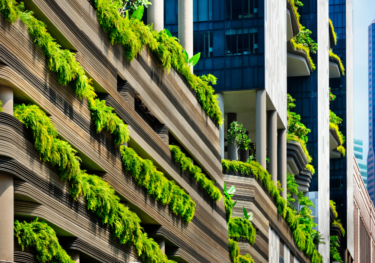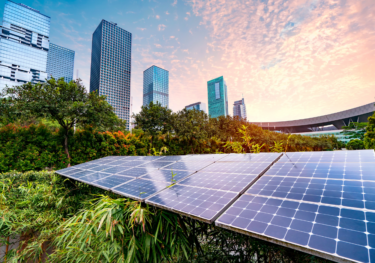Podcast | 22 Nov 2023
Greenomics – Ep. 5 | Building a Greener Tomorrow: Climate Compatible Construction

Sarah Nelson
Senior Economist, Economics & Sustainability

A climate, sustainability and economics podcast from Oxford Economics
In this episode of Greenomics, experts Sara Wilkinson and Kristian Kolding join Sarah Nelson to discuss the crucial role of climate-ready buildings in the global push towards a net-zero future. They delve into sustainable construction practices, the importance of regulations, retrofitting existing buildings, and behavioural changes to create environmentally friendly homes. The conversation also touches on the economic challenges and choices associated with transitioning to sustainable living.
Subscribe on: Spotify | Soundcloud | By Email
Sarah Nelson:
Welcome to Greenomics, a podcast from Oxford Economics, where we delve into the complex relationships between climate, nature, and our global economy. I’m your host, Sara Nelson, in the economics and sustainability team here at Oxford Economics. And together we’ll be navigating the changing landscape of the green transition. Each month will be joined by a panel of experts to discuss one aspect of sustainability and unpack what it means for businesses in today’s economy.
Today, we’ll be speaking about climate ready construction. Our built environment is hugely important for climate change and obviously for our lives. I know that the electricity and gas that I use in my home has climate impacts, but there’s only so much I can do to reduce my energy use when my walls aren’t insulated, and my windows aren’t double glazed. So how our buildings are well, built is incredibly important.
Today we’re going to find out how the construction industry is preparing for a net zero future. I’m very happy to be joined by Sarah Wilkinson and Kristian Kolding. Sarah is a professor of property at UTS in Sydney, Australia. In fact, she was Australia’s first female professor of property. She’s also a chartered building surveyor and has been advising on green building practices for more than 30 years. Sarah, welcome. It’s great to have you on.
Sarah Wilkinson:
Thank you, Sarah.
Sarah Nelson:
Kristian Leeds, Oxford Economics, Australian Consulting Business, where our construction forecasting team is based. He’s an expert at assessing economic outlook and understanding how key trends such as global warming will affect the economy, policy, and businesses. Kristian, thanks for joining us.
Kristian Kolding:
My pleasure. Great to be here.
Sarah Nelson:
Now, before we dive into the questions, I just wanted to say that I’m thrilled to have some guests from my part of the world, I’m from New Zealand but outside of sports, we secretly love our Australian cousins. Sarah and Kristian, you’re both most familiar with the Australian context, I think, but sustainable construction is obviously a challenge everywhere. So, can we draw international insights from your experiences and expertise in Australia?
Sarah Wilkinson:
Absolutely. You know, I think we can all learn from each other. That’s an absolute given, and I think it’s really good to listen to how people do things in other countries. I’m actually based in Sweden for a couple of months and the buildings here are so well insulated. It’s late October and I’m sleeping with the door open.
Sarah Nelson:
Well, I have to say that that is not the case in Britain, but good to know that we can take international lessons from your expertise. So looking forward to getting into it. Kristian, I will start with you on a bit of a context question. Why is it important that we have sustainable buildings?
Kristian Kolding:
It’s important to have sustainable buildings, basically, because living in our houses, it contributes to emissions and it contributes to climate change. So it’s kind of simple stuff. By being in a house, and particularly by heating up the houses, using electricity, heat and using gas to cook our food, all of that emits CO2 emissions. And so, by having more sustainable housing and getting the double glazing windows, for example, as you mentioned, Sarah, it makes a big difference. You know, again, just looking at the Australian context in Australia, about 10% of our CO2 emissions comes from the fact that we live in houses and we use CO2 and living in houses. That’s a that’s a fair bit. Now, obviously, of that 10%, the vast majority of the emissions is actually from using electricity, using power. So what we can really do about it is, is reducing our power usage. If we dig a little bit deeper where the power usage comes in, so it is actually around heating and cooling homes. So in Australia, about 66% of our electricity use in homes comes from heating and cooling. So that’s really where you get bang for buck.
Sarah Nelson:
There’s been so much policy moves internationally around climate change. Has the regulation in Australia changed to make those building related climate challenges?
Kristian Kolding:
Yeah, we’re seeing regulation globally, but also in Australia continue to just nudge up and seek higher and higher standards for sustainable living right across the world. In Australia we actually introduced what’s called a seven star Navis rating for new buildings in October. So that’s recently come in earlier this month. It will make a difference. It’s focused on new builds. It’s got a lot of useful requirements, a quite pragmatic and practical requirements to ensure that we’re building more sustainable homes. But of course, there’s also a long way to go.
Sarah Nelson:
So this was just passed in October. So why now?
Kristian Kolding:
I think it’s momentum that’s been building for a long time. Just to be clear, this was implemented in October. It was actually passed last year. It’s been quite a while for the building industry. They’ve had to get used to the rules, understand the rules, understand the requirements. And that is one of the reasons why change can be seen as being relatively slow is because it’s also hard and we have to respect that It’s hard to change. So really, I think it’s an ongoing shift towards being more climate conscious, more being more environmentally friendly. And it’s a global push has been really building over the last decade in particular. One of the really interesting things, though, that I’m reflecting on now from a macroeconomic perspective is how well the desire to be climate conscious stacks up with the cost of living crises that we are facing right across the world today. I think that is actually a real challenge for the green economy because we are starting to have to make some very real day to day choices about where we put our money, where we put our efforts, where we put our energy.
Sarah Nelson:
Yeah, that’s really interesting. And Sarah, I was going to ask you about that. I know you do some thinking and you work in the in the sphere of the different challenges facing housing. How do you know the cost of living crisis and the housing crisis, How do they all interact with the sustainable building movement?
Sarah Wilkinson:
Well, as you can imagine, it’s complicated. Yeah, I mean, the cost of living is affecting people in countries all over the globe at the moment. And obviously, depending on what measures you use, you’ve got a payback time. So I’m really interested in retrofitting buildings to improve their performance. And so what you’re looking at is how much does a measure cost, whether it’s insulation in, say, roof spaces or retrofitting secondary glazing or new double or triple glazing. What’s the cost to that and what’s the savings? And obviously with energy bills going up that if providing that, the measures that you install don’t also have an increasing cost. Your payback times might be shorter. The other thing also is with construction, typically we add about 1% to the total stock of buildings with a typical sort of turnover. So waiting for the new stock to replace the old stock, we don’t have enough time for that. So we’ve got to focus also on retrofitting and upgrade the existing stock. Some measures, for example, perhaps external shading, can deflect sunlight from a building so you don’t get that heat gain as much heat gain in the summer, having sort of heavy curtains. You might not get so much heat loss in the winter. They could be relatively low cost measures that some homeowners could easily adopt. The other thing is behaviour. So, for example, I’ve just put solar panels on the roof of my house, can’t yet afford a battery, but it does mean in the summer when it’s really hot, I could run a portable air conditioner with zero impact, seal up all the doors and everything. And so it’s just learning new ways of doing things and when to vent buildings to let hot air escape and that sort of thing. You know, like I say, Kristian’s.
Kristian Kolding:
Yeah, I just thought Sarah was just a couple of points there that couldn’t help but jump on. First one is just anecdotal. The solar panels on the roof are we’ve done the same in my house here and it’s amazing we didn’t get the battery either. But it’s amazing how just by having more information, you start changing your habits. So, I got one of those fancy pants apps, which tells me exactly how much power I’m using, every 5 minutes of the day and how much power generating, and all of a sudden being a bit of a data nerd, and economist, you start gamifying this stuff and all of a sudden the dishwasher only goes on sunny days in the middle of the day. It doesn’t run overnight the that the washing machine only goes on during the day and the dryer or that’s a game over you lose a life and you use that one. So it’s amazing how information can really help encourage green living and sustainable housing. It’s really made a big difference.
Sarah Wilkinson:
Yeah and that’s the thing. Is learning those new behaviour’s and it’s not easy for everybody. That’s the thing. So, I think what we need to ensure is the communication that goes with these things so that people can optimize the benefits that they’re getting from these technologies.
Sarah Nelson:
I mean, a lot of construction related policy, or at least when I think of construction related policy, it’s all about new builds. You know, what are the regulations and how much insulation do you have to have, how much glazing etc.
What can policy do or what does policy do on the demand side? And also on retrofitting.
Sarah Wilkinson:
You can have I mean, years and years ago we had the pink batts program, which was an incentive by government to install insulation into existing buildings. And so you got a discount, I think it was on and the program was only open for a certain period of time. So that creates some sort of urgency for people to get that. I think also having the building ratings, you know, the energy rating things. So yeah, when you’ve got a certain rating level, depending on the property market, that might start to make a difference. If you’ve got a market where it’s quite difficult to sell and so you’re competing with perhaps a lot of other stock on the market, then people are going to really delve into what are all the benefits. Interestingly, I’ve just spent weekend in the UK and talking to family members that are in the building game, properties on the market housing for two years not selling, it’s quite standard over there at the moment, which just seems amazing having come out of such a heated market in Australia, certainly in the sort of early 2020s when properties might not be on the market for a week before they were and bidding wars and what have you, a slightly different market now in Australia I think.
Sarah Nelson:
I guess that that point on the sort of energy certificates, what we and the UK energy performance certificates that UPC and yeah it goes back to Kristian’s point and certainly something that I started paying a lot of attention to when I moved into very, very chilly rented houses. And that sort of brings me to another question, which is obviously for homeowners who live in their own home, the payback period is a factor, but for landlords they don’t get the benefits and in the UK we’ve actually just had a sort of backtracking on some of the policy around requiring landlords to increase the energy efficiency of their homes, which as the renter was disappointing, but what’s going on there? What’s it like in Australia?
Sarah Wilkinson:
They call that the split incentive where one party pays and the other party benefits. So, what you’re describing is if I as a landlord pay to retrofit secondary glazing and insulation and perhaps change some of the heating systems, I’m going to pay for that. But you’re going to benefit from lower energy bills and a more comfortable property. If I can perhaps offset some of those costs on tax, that might make it not so painful for me as a landlord. If I get an uplifting value, capital value of the property, then you know, that’s good. So that if I do sell it, I’m going to get a higher value and possibly a quicker sale. Or if I can possibly, then increase the rent by some amount to account for some of the reductions that the tenants are going to get. And again, it would depend on that the rental market is like. If it’s really hot, or really slow, really cold, you know, different things are going to work or be appealing.
Sarah Nelson:
Right, Yeah, that makes sense. I guess there’s just so many factors and incentives coming into play. There’s a lot of policies to be made, I suppose.
Sarah Wilkinson:
Yeah.
Kristian Kolding:
On the policy point, I thought there’s not a good example quite recently, which is the 110% super bonus policy which was introduced in Italy following the COVID or Corona. So, what they did there was introduced a significant tax incentive to retrofit apartments and buildings and houses to be more environmentally green, and it had two big benefits: one being converting the stock of housing to be more environmentally friendly. The other one was to reignite a stimulate the economy coming out of COVID. So, it was another way of actively stimulating the economy back a year or two, a year and a half ago, which has been very it was very attractive and really had a lot of uptake very quickly.
Sarah Wilkinson:
That’s a really good point, actually, Kristian, because I think it depends on which government is in power and, you know, their kind of worldview of economic policy making. But it’s good to see examples of where, you know, an environmental program can be adopted quite quickly and stimulate the economy, but also deliver better environmental outcomes.
Sarah Nelson:
Yeah,
Kristian Kolding:
two birds with one stone.
Sarah Nelson:
Exactly. Every policymakers dream.
Sarah Wilkinson:
Yeah.
Sarah Nelson:
Stepping back a little bit or potentially in a different sphere. Kristian, a question for you. How do the energy and commodities crunches, which we’ve seen kind of ebbing and flowing over the last couple of years, how do they affect construction?
Kristian Kolding:
It’s a good question. And it actually relates a little bit back to what Sarah was talking about before being the fact that new builds only contribute a fairly small amount to changing the overall stock of buildings because a house last for decades and decades. Now, if you take that as a starting point and then add in the price disruptions that we’ve seen, you start getting into real trouble on this front really. So, what’s happened was during COVID, we had all this supply chain disruption where we see out of freight and container ports being shut down and all sorts of things. And then just as we saw things loosening up a little bit again, we had the war in Ukraine erupts. That’s meant that prices for a huge amount of raw materials went through the roof for quite a period of time before we started seeing it on a cost of living basis. So, this actually happened probably a year or so before we started sort pf feeling it at the supermarkets. That has a couple of effects on the desire or incentive to build a new house. First effect is if you’re about to build and you haven’t fixed your building costs, you probably hit the brakes and say, Oh, hold on. I thought this new house is going to cost me $200,000. Now it’s going to cost me $300,000. That makes a big difference. I’m going to just hold my horses. So, there’s quite a few. But what we’ve observed is there was quite a few approvals which haven’t turned into housing commencements because people have just said, nope, don’t want to do it. The other thing that’s happened is four builds wherein the builder had promised a fixed price contracts, the owner was still happy to go ahead with it. But what’s happened is that the actual builder has now got squeezed and we start to see a lot of builders going into bankruptcy because they’re promising to deliver buildings at a price that’s just not commercially sustainable. And so, what that means is that we start to see also not just approvals not turning into commencements, but also commencements not turning into completions and result is that you’re just not seeing very many houses being built at the moment. Now, on top of all that, you start seeing interest rates rise. Now we’ve all experienced the rise in interest rates. That has a direct impact on our cost of living. People who’ve got mortgages are paying more mortgages, people who’ve got debt, are paying more debt, often they’re also the people that are about to build new houses. And that makes it even more difficult to stimulate new housing growth. And so you’re starting to see, despite the fact that regulatory changes are encouraging greener houses being built, we’re now in a world where fewer houses are actually being built and the houses that are being built, they’d be built in a much more cost conscious way. So that decision about do I get my double-glazed windows, or do I go a single glazing? That becomes a harder decision to make because you’ve already seen the cost of cement, the cost of timber, the cost of your windows really increased much more sharply than what you’re expecting prior to starting the build. So that’s making it that’s making things really quite challenging.
Sarah Nelson:
And how that affects decarbonization, timelines, I mean, can we expect to see and a swifter acceleration once these crunches lift or is it just going to slow everything down?
Kristian Kolding:
You do tend to see a degree of catch up because the population still increases. So, we still need the houses and the still need to be built at some point. So, you do tend to see a degree of catch up. But again, when that catch up comes, chances are all the builders are going to be very busy because a bunch of them left the industry while things were dire and now everyone’s asking for more building to be done. So you start having a labour market shortage that’s seeing the actual margins on houses started to increase. And so again, you end up in this world where demand and supply is just misallocated for quite some period of time following a disruption like this, which means that housing becomes continually more expensive to build. And so those decarbonization decisions which you’d like to think would be quite voluntary, you know they become less and they become harder and harder to make because you are really conscious of, of the cost of building. So I don’t think this, it’s hard to put a positive spin on on what’s happening right now. But we also have to remember we’re starting from the basis we’re in. It’s never going to be enough just to focus on new builds. So, unless we really manage to shift the lens away from just a focus on new builds to retrofitting the current stock, we’re just not going to be able to make a big enough difference. Quick enough.
Sarah Nelson:
Yeah, sure, that makes sense.
Kristian Kolding:
One thing that we have to remember is the fact that the emissions that are created from living in houses come from our use of electricity. That’s where the vast majority of emissions come from. That electricity is currently generated using a lot of fossil fuels, which is why it causes emissions. Yeah. One thing we have to think about is if we were to successfully decarbonize the electricity grid and successfully produce much, much, much more green electricity than what we’re doing now, then we have to remember that a lot of these issues that we’re discussing today, they start going away because we are able to keep the lights on and turn on the air conditioning and maybe even use a dryer all we like if we are able to source the electricity to do so from a green and sustainable renewable source. So, I think that’s a really important point that we just need to keep in mind that while we want to make sure that we promote sustainable housing and push in that direction as fast as possible, there is a very, very, very big lever running in the background, which is decarbonizing the electricity grid. And that’s an important one to keep in mind for the medium to long term perspective, in particular.
Sarah Wilkinson:
Actually, I just had a visit to Germany, to Munich, and I was absolutely amazed at the amount of solar panels in fields. They’ve just got field after field after field of solar panels and a lot of them seem to be located next to railway lines and motorways where you’ve got sort of noise pollution from the transport systems. So they’re not so desirable for building housing, etc.. And you know, one thing we do have in Australia is a huge amount of land.
Sarah Nelson:
and sun.
Sarah Wilkinson:
Yes, yes.
Sarah Nelson:
Yeah, absolutely. So we have been delving into the dismal science a bit too much perhaps. So, imagine yourself, Sarah, in 2050 and we’ve had a successful transition to sustainable homes and you’re living in your lovely, sustainable home. What does it look like?
Sarah Wilkinson:
Well, I guess it’s a combination of good design, which looks at the climate in that area. So, the orientation, the location of rooms on different sides of the building, the size of the window openings and shading, the amount of, you know, hopefully passive solar, you know, thermal insulation. I’ve actually got a project at the moment evaluating the performance of hempcrete wall panels and green walls. Nobody has put those two materials together and actually tested its environmental performance. So yeah, it might even be a hempcrete property with green walls ,solar panels on the roofs or bio solar because again, research that some colleagues of mine have done with Lendlease in Sydney found that the performance of solar panels on green roofs was actually better than solar panels on traditional roofing. So
Sarah Nelson:
And what about that sort of community aspects of sustainable housing, are there projects that you’ve worked on which just are about sort of linking up homes and changing behaviours at a community level or anything like that.
Sarah Wilkinson:
Yeah, actually we, we did a project that finished a couple of years ago just pre-COVID. Frasers were the developers out to a site called the Fair Water Project in Western Sydney. And that was a new site on, I think, a former golf course. And what the developer decided was to keep some of the features of the golf course, like the green and create a bit of a sales suite / community center around that location. They were also using ground source heat pumps as this sort of sustainable technology. And they were strong marketing campaign on the sustainable buildings. But the community sharing of knowledge and experience was very strong there.
Sarah Nelson:
For a sustainable move. That would be good. I think on a community level that would also be a positive shift.
Sarah Wilkinson:
I’ve always thought it’s easier to save a dollar than earn a dollar, you know? And so just looking at your, you know what, you can sort of cut back home without drastically affecting your quality of life. Um, you know, there’s often things to do with shutting doors, opening windows at different times. And as, Kristian was saying, having the dryer on when you’ve got the solar power. Sunny day
Sarah Nelson:
Yeah, that’s a very good pearls of wisdom. So, I think we actually might wrap up the questions there. So, it is now time for the Greenomics Gamble. So, I mentioned this earlier. I have three statements about sustainable buildings, two of which are true and one of which is false. So, it’s up to you to pick the lie and you can work together and agree or you can stoke some competition, it’s up to you. But good luck.
So, the first statement is that the construction industry is the world’s largest industry, generating 13% of global GDP. The second is that embodied carbon and buildings, so not the carbon that’s generated from energy use, but that the emissions that are associated with the materials and the construction of buildings themselves, these emissions account for 1.1% of total global emissions. The third statement is that in the USA, 270,000 homes are demolished annually. What do you think?
Kristian Kolding:
I suppose in the first one, construction being the largest industry, it all depends on how you split your industries, I suppose. But an industry as big as 13 to 14% of the overall economy, if that’s the ways its defined, that is pretty big. So, there’s a good chance of that being correct because it suggests more than ten industries, which there tends to be. So, I’d like to think that’s probably correct. What was the last point.
Sarah Nelson:
270,000 homes in the US are demolished every year.
Sarah Wilkinson:
I mean what’s the population of the US and divide 50 mil. Yeah. Something.
Sarah Nelson:
Yeah. 350. 300. 400 mil.
Sarah Wilkinson:
Yeah. Divide by probably 2 to 3 thinking.
Kristian Kolding:
That’s the amount of households. 1 million homes, 1%. So it’s 0.2% of all houses. That doesn’t sound like enough to me. The I would have gone with something like 2% of all houses, so I would have thought maybe 2 million homes gets depreciated or destroyed. I’m not sure about c. What was B.
Sarah Nelson:
B was the embodied carbon of buildings being 1.1% of total global
Sarah Wilkinson:
possibly under, I would think because you know, the, the built environment takes a huge in involves a huge lot of energy for building and especially as currently have preferences are for high energy materials like concrete steel metal aluminium.
Sarah Nelson:
Actually, it is number two. So I don’t know if it was new buildings or old or existing buildings as well, but from the World Green Building Council, it’s actually 11%, so 11% of global emissions. Are associated with the embodied carbon in buildings. Yeah, so that’s a lot. And it also, we didn’t touch on really sort of green construction materials today, but that is a big, big proportion of that. well, with that, we’ll wrap up. So, all this is to do is to say thank you very much, Sarah and Kristian, for joining me. It’s been great to have you on the show.
Sarah Wilkinson:
Our pleasure. Thank you.
Kristian Kolding:
Thanks for having us.
Sarah Nelson:
And thank you also to the listeners for tuning into this episode. Please subscribe on Spotify, SoundCloud or on our website and feel free to write to us at ‘[email protected]’. That’s it for today on Greenomics from Oxford Economics, where we know that money might make the world go round. But sustainability makes it a much nicer place to live. See you next time.
Our Panel

Sarah Nelson
Senior Economist, Economics & Sustainability
+44 (0)203 910 8000

Sarah Nelson
Senior Economist, Economics & Sustainability
London, United Kingdom
Sarah is a Senior Economist in the Economics & Sustainability team at Oxford Economics. She works with clients to understand their environmental impacts and dependencies, and helps them achieve their sustainability goals. She has professional and research experience in the economics of decarbonisation, energy policy and environmental and economic impact assessments.
Prior to joining Oxford Economics, Sarah worked in economic consulting in Sydney and London, where she worked on energy regulation, anti-trust, carbon forecasting and social welfare assessments. She holds Bachelor’ degree in economics and physics from the University of Auckland, and a Masters in Economics from the University of California, Santa Barbara, where she was a Fulbright Scholar. Sarah completed a PhD in climate economics and policy from the University of Cambridge in 2021.

Kristian Kolding
Head of Consulting, OE Australia
+61 (4) 1040 9070

Kristian Kolding
Head of Consulting, OE Australia
Sydney, Australia
Kristian leads Oxford Economics Australia’s Consulting team, working with public and private sector leaders to help them prepare for the future by applying relevant economic theory and forecasts to inform effective policy and business strategy development.

Sara Wilkinson
Chartered Building Surveyor

Private: Sara Wilkinson
Chartered Building Surveyor
Sara is a chartered building surveyor and Australia’s first female professor of property. She is a Fellow of RICS and a member of the API (Australian Property Institute). Her transdisciplinary research program sits at the intersection of sustainability, urban development and transformation, with a focus on green cities and preparing our urban environments for the challenges of climate change.
Current, and recent, projects include the STAR (Sustainable Temporary Adaptive Reuse) Toolkit, the use of virtual reality to assess customer willingness to pay for green infrastructure in residential property, the development of a prototype wallbot to inspect and monitor high-rise green walls, and the performance evaluation of hempcrete wall panels. Sara’s trans-disciplinary research involves colleagues from engineering, science, health and business as well as built environment disciplines.
Sign up for the latest podcast straight to your inbox
Resources and Events

Consulting Report
Mapping the Plastics Value Chain: A framework to understand the socio-economic impacts of a production cap on virgin plastics

Blog
How Canada’s wildfires could affect American house prices

Research Briefing
Beyond assumptions – the dynamics of climate migration

Podcast
Greenomics – Ep. 9 | The nature of Travel & Tourism

Webinar
Global Climate Service – Differentiated outcomes

Webinar
Global Climate Service: An Equitable Path for Sustainable Development

Webinar
How to manage sustainability risks over time

Webinar
Global Climate Service – From Bright to Bleak: Taking Stock of Climate Futures

Sectoral winners and losers from the energy transition
Featured
Tags:
